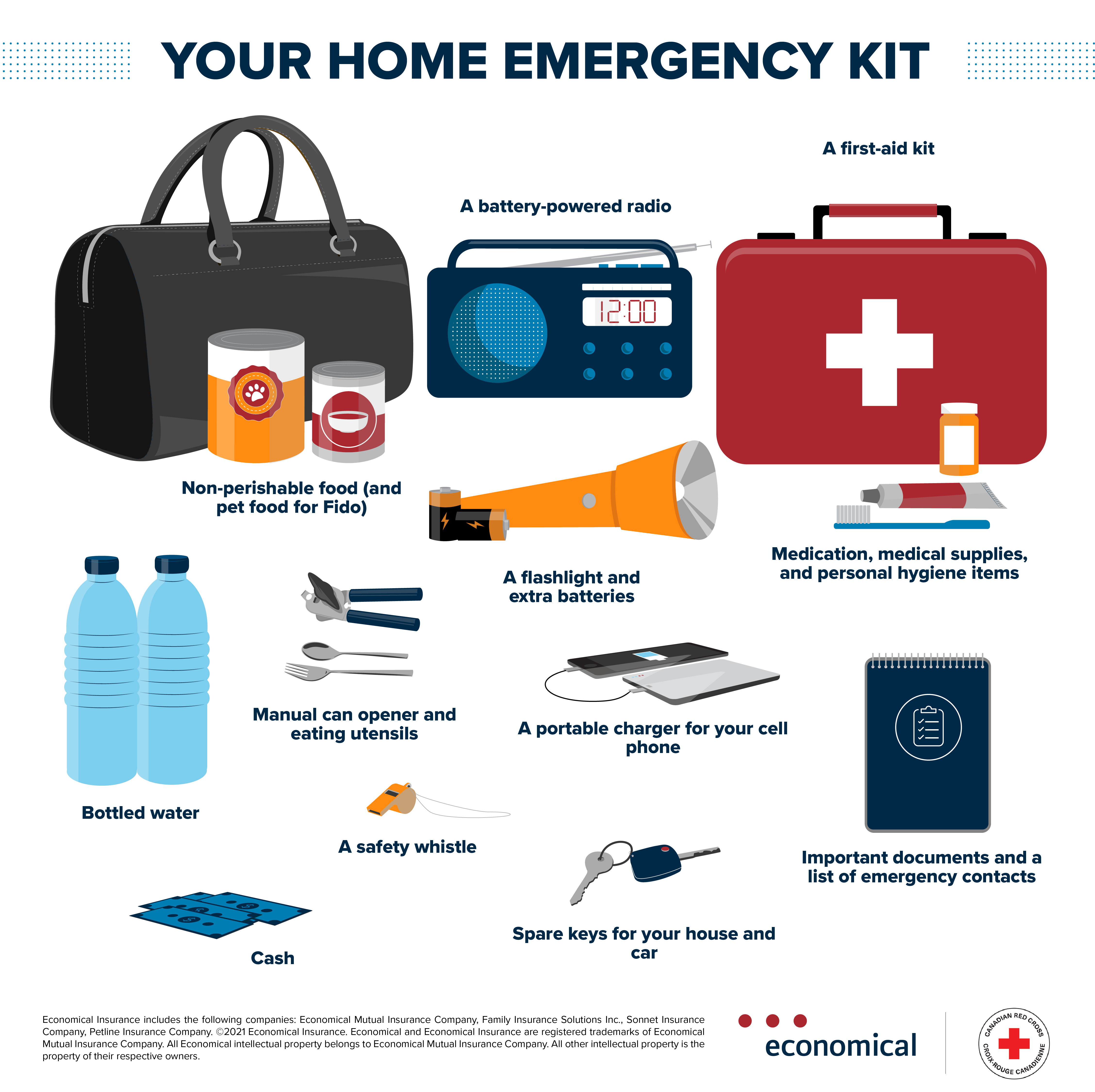10 items to keep in your home emergency preparedness kit
Written by Economical Insurance | Published on: May 5, 2021 | Categories: At home
This article is presented in partnership with the Canadian Red Cross.
Some severe weather events (like hurricanes, wildfires, earthquakes) may require you to evacuate your home at a moment's notice, while others (like snowstorms and extended power outages) could leave you stuck at home for days on end, potentially even without power or running water. Having an emergency preparedness kit stored in a clean, dry, and accessible place can ensure you have everything your family needs on hand. Build your own kit by packing these essential supplies in a sturdy and easy-to-carry bag or two:
- Bottled water. Your emergency kit should contain at least three litres of water per person per day, with one litre for drinking and two litres for cleaning and hygiene. For example, if you have a family of three, you should pack nine litres of water a day for at least three days. If you have a family pet, pack an extra litre of water per day for them. This may seem like a lot of water, but when you consider that the average Canadian uses approximately 329 litres of water every day at home, it’s a drop in the bucket (no pun intended) and you’ll be thankful you have it.
- Non-perishable food (including pet food). Pack enough non-perishable food items like canned meats, protein bars, dry cereal, peanut butter, canned juices, and pet food to last each person or pet in your group at least three days. When buying food for your kit, be sure to buy items with a long shelf life, and check your kit every year to make sure your items haven’t expired.
- Manual can opener and eating utensils. If you include canned food items in your kit, a manual can opener is a must-have in addition to utensils like forks, spoons, and knives.
- Medication, medical supplies, and personal hygiene items. Pack extras of any items you can’t be without, including medications (and copies of your prescriptions), eyeglasses or contacts, pet medications, and any supplies you or your family members need for specific medical conditions. You’ll also want to pack portable personal hygiene items like toothbrushes, toothpaste, and soap.
- Important documents. Consider including copies of birth and marriage certificates, passports, health cards, wills, insurance policy documents, and a list of emergency contacts in your emergency kit. In addition to paper copies, consider saving electronic copies of important documents on an encrypted USB stick or in a secure, cloud-based account.
- Electronics, batteries, and chargers. Buy a crank- or battery-operated flashlight and radio for your kit, as they’ll be handy to have in the event of an extended power outage. It’s also important to pack extra batteries, an extra cellphone charger, and a pre-charged cellphone battery pack.
- Spare keys for your home and cars. Make extra copies of your home and vehicle keys to include in your kit. You may also want to consider leaving another set of keys with a trusted friend or family member.
- First aid kit. A standard first aid kit should include sterile gauze pads, adhesive tape, roller bandages, adhesive bandages, scissors, tweezers, safety pins, instant ice packs, and more. Check your local pharmacy for a prepackaged first aid kit to add to your emergency kit.
- Extra cash. In the event of a widespread power outage, stores (if they’re open) won’t be able to take credit cards or mobile payments, and you won’t be able to withdraw money from your bank. Keep extra cash in the form of small bills and coins in your kit in case you need to buy extra supplies.
- Safety whistle. If you’re lost and need help, you can use a safety whistle to alert others and assist search and rescue teams in finding you.

(Viewing this from your smartphone? Click here to enlarge.)
Your home emergency kit
- Non-perishable food (and pet food for Fido)
- A battery-powered radio
- A first aid kit
- Bottled water
- Manual can opener and eating utensils
- A flashlight and extra batteries
- Medication, medical supplies, and personal hygiene items
- A portable charger for your cell phone
- A safety whistle
- Cash
- Spare keys for your house and car
- Important documents and a list of emergency contacts
Looking for more ways to get prepared for a severe weather event? Watch this quick video to learn how you can protect your property and loved ones during an emergency at home:

How to prepare for an emergency at home
Be prepared for any emergency. Follow these tips to plan ahead and keep your household safe if the unexpected happens.
- Tune in to your local news for the latest forecast and updates.
- Write out an emergency exit plan. Map out your home and the surrounding area to plan an exit route and safe meeting place just in case you need to leave your house in a hurry.
- Review your emergency contact list. Write down the names and numbers of local emergency services, your utilities providers, your relatives, your family doctor, and your insurance broker.
- Keep your emergency kit stocked up. Your emergency kit should contain at last three days’ worth of supplies, including cash, a battery-powered radio, non-perishable food, water, a first aid kit, flashlights, and blankets.
- Review your home and car insurance policies. Make sure you have the right coverage! Look through your insurance policies at renewal time and double-check that everything is up to date. Reach out to your broker if you need to make a change.
Protect what matters most.
There are plenty more items that could help you out during an emergency evacuation or if you’re stuck at home, including sleeping bags, warm blankets, paper maps, and a change of clothing and footwear for each person in your home. Check out this list of additional items to pack in an emergency kit from the Canadian Red Cross to take yours to the next level.
What to do if your home is damaged because of a severe weather event
If you return home and see that your home has been damaged because of a weather-related emergency, reach out to your broker or call your insurance company’s 24-hour claims service line right away.
Share this checklist on Facebook or Twitter to help your family and friends get prepared for emergencies, too.